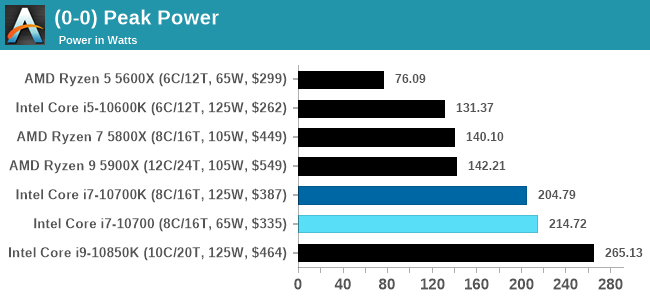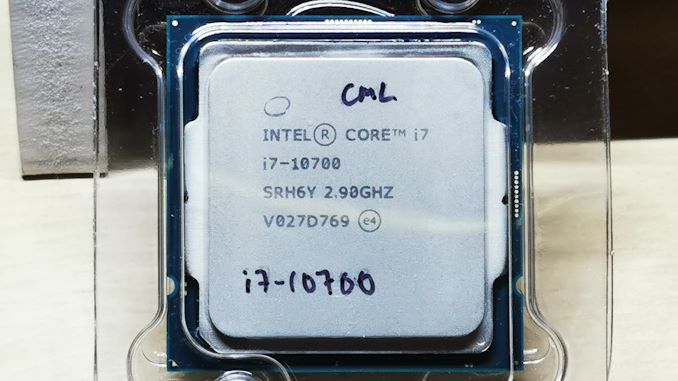Intel Core i7-10700 vs Core i7-10700K Review: Is 65W Comet Lake an Option?
by Dr. Ian Cutress on January 21, 2021 10:30 AM EST- Posted in
- CPUs
- Intel
- Core i7
- Z490
- 10th Gen Core
- Comet Lake
- i7-10700K
- i7-10700
Conclusion: TDP is Not Fit For Purpose
In years gone by, processors were sold with a single frequency and power rating. It was very quickly realized that if a processor could effectively go to sleep, using either lower voltage or lower frequency (or both) then a lot of idle power could be saved. Going the other way, processor designers realized that for temporary short bursts, a core could run at a higher frequency before it reached a thermal limit. Also, using a multi-core processor meant that either the power budget could be shared across all the cores, or it could be focused in one.
Both AMD and Intel have noticed this over time, and both companies have different attitudes on how they report numbers relating to ‘base frequency’ and related power as well as the bursty ‘turbo frequency’ and related power. Out of those four metrics, the only one Intel doesn’t provide is turbo power, because from their perspective it is system dependent.

Intel lets motherboard manufacturers determine how long a system can turbo for, and what that budget is. Intel encourages motherboard manufacturers to over-engineer the motherboards, not only for overclocking, but for non-overclockable CPUs to get the best performance for longer. This really messes up what the ‘default out-of-the-box performance’ should be if different motherboards give different values. The trend lately is that enthusiast motherboards enable an unlimited turbo budget, and the user building their system just has to deal with it.
This means that users who buy the Core i7-10700 in this review, despite the 65 W rating on the box, will have to cater for a system that will not only peak around 215 W, but sustain that 215 W during any extended high-performance load, such as rendering or compute. We really wished Intel put this 215 W value on the box to help end-users determine their cooling, as without sufficient guidance, users could be hitting thermal limits without even knowing why. At this point, 'Intel Recommended Values' for turbo time and budget mean nothing outside of Intel's own OEM partners building commercial systems.
Core i7-10700 vs Core i7-10700K Performance
In the review we highlighted that these two processors have a peak turbo frequency difference of 300 MHz and an all-core turbo frequency difference of 100 MHz. The fact that one is rated at 65 W and the other is rated at 125 W is inconsequential here, given that most end-user motherboards will simply enable turbo all the time. This means the performance in most of our tests between the two is practically identical, and consummate to a 100-300 MHz frequency difference.
In practically all of our tests, the Core i7-10700K is ahead by a super slim margin. At $387 for the 10700K compared to $335 for the 10700, the performance difference is not enough to warrant the $52 price difference between the two. Performance per dollar sides mostly with the Core i7-10700, although users getting the i7-10700K will likely look towards overclocking their processor to get the most out of it – that ultimately is what to pay for.
The other comparison point is with the Ryzen 5 5600X, which has two fewer cores but costs $299. In practically every test, the increased IPC of the Ryzen over Intel means that it sits identical with the Core i7 processors, AMD is cheaper on list price, and at a much lower power (AMD will peak around 76 W, compared to 215 W). AM4 motherboards are also abundant, while corresponding Intel motherboards are still expensive. The problem here however is that AMD is having such high demand for its product lines right now that finding one in stock might be difficult, and it probably won’t be at its recommended price.
Users in this price bracket have a tough choice – the more efficient AMD processor that might be in stock, compared to the Intel processor that will be in stock but more cooling will likely be required.











210 Comments
View All Comments
bji - Thursday, January 21, 2021 - link
To clarify: 95% was an exaggeration. Micro Center has like 20 or 30 stores and is accessible by more than 5% of the USA population. But it's probably not more than 20%. Anyway any store that is not available to the majority of people cannot be called "general availability".bji - Thursday, January 21, 2021 - link
I mean seriously. If Micro Center were that easy to get through, would there even be a shortage of these chips at online vendors? Everyone would already be satisfied by the Micro Center supply. But a) the fact that there is online shortage means very clearly that most people can't get one from Micro Center (otherwise they already would have and there would not be zero supply online), and b) if a significant fraction of the population could actually get them from Micro Center, Micro Center would clearly already be sold out also.magreen - Friday, January 22, 2021 - link
@bji: How do you feel about Microcenter?calc76 - Friday, January 22, 2021 - link
I'd suspect its probably well more than 50% of the US population is within an hour drive of a Microcenter. The names of the cities listed on their site aren't all easily recognizable but the metro areas are almost all the large ones.Atlanta
Baltimore
Boston
Chicago
Cincinnati
Cleveland
Columbus
DC
Detroit
Denver
DFW
Houston
Kansas City
LA
Minneapolis
Newark
NYC
Philadelphia
St Louis
Dug - Friday, January 22, 2021 - link
They were actually available today at Amazon for a very long time at @299. Of course it's back up again after mass ordering at the time I'm posting this.bji - Friday, January 22, 2021 - link
I checked several times today. How did I miss that? I doubt it was for a very long time. Probably closer to that 10 minutes I mentioned.jimbo2779 - Friday, January 22, 2021 - link
Nephew bought a 5600x for MSRP here in the UK from Currys which is by far the largest national chain of electronics and computer equipment.You could try signing up for an alerts service, providing you have the funds ready to put down you could likely have one in the next week or so. Not as ideal as next day from any major retailer but the chips are coming in stock.
Spunjji - Friday, January 22, 2021 - link
UK here. They do mention low availability of that chip in the article, but I notice that didn't prevent you coming here to whinge about it anyway.From my perspective in the UK, they have 10+ in stock at Overclockers for £299.99 and unspecified stock at CCL for £309.
I must say I especially enjoyed how you elaborately set up the goalposts in your first post, then moved them around with every response. Good game!
bji - Saturday, January 23, 2021 - link
No goalposts were moved. If you'd care to elaborate, I'd respond. Or were you just whining about my whinging?Spunjji - Monday, January 25, 2021 - link
That last bit. 👍Your original post said that none of the processors have had general availability and that it would be months before prices hit MSRP. People have pointed out a few times that in various parts of the world, availability is there and prices are at (or very near) MSRP, yet you've still found reasons not to admit that maybe you overstated things a bit.